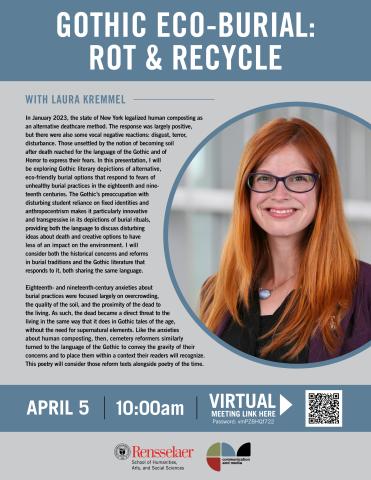
April 5
10am-12:30pm
Virtual: https://rensselaer.webex.com/rensselaer/j.php?MTID=m1a69a6214f0adc3b24f759b95fe71e6c
(Password: vmPZBHQf722)
In January 2023, the state of New York legalized human composting as an alternative deathcare method. The response was largely positive, but there were also some vocal negative reactions: disgust, terror, disturbance. Those unsettled by the notion of becoming soil after death reached for the language of the Gothic and of Horror to express their fears. In this presentation, I will be exploring Gothic literary depictions of alternative, eco-friendly burial options that respond to fears of unhealthy burial practices in the eighteenth and nineteenth centuries. The Gothic’s preoccupation with disturbing student reliance on fixed identities and anthropocentrism makes it particularly innovative and transgressive in its depictions of burial rituals, providing both the language to discuss disturbing ideas about death and creative options to have less of an impact on the environment. I will consider both the historical concerns and reforms in burial traditions and the Gothic literature that responds to it, both sharing the same language.
Eighteenth- and nineteenth-century anxieties about burial practices were focused largely on overcrowding, the quality of the soil, and the proximity of the dead to the living. As such, the dead became a direct threat to the living in the same way that it does in Gothic tales of the age, without the need for supernatural elements. Like the anxieties about human composting, then, cemetery reformers similarly turned to the language of the Gothic to convey the gravity of their concerns and to place them within a context their readers will recognize. This poetry will consider those reform texts alongside poetry of the time.